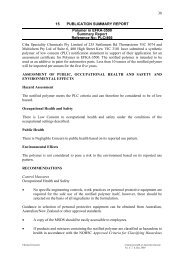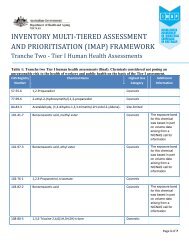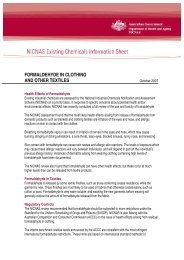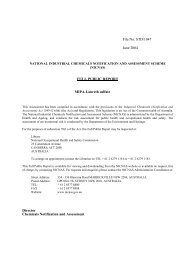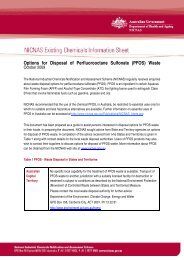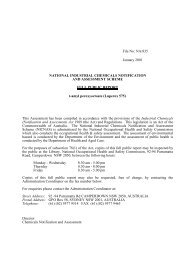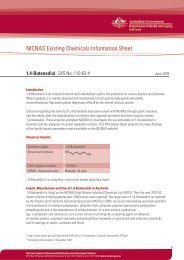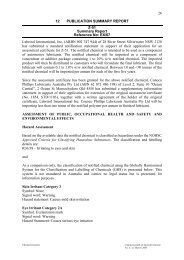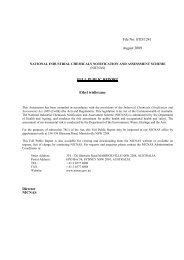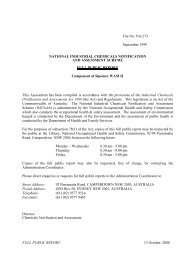GULFTENE C16-18 ISOMERISED OLEFINS - NICNAS
GULFTENE C16-18 ISOMERISED OLEFINS - NICNAS
GULFTENE C16-18 ISOMERISED OLEFINS - NICNAS
You also want an ePaper? Increase the reach of your titles
YUMPU automatically turns print PDFs into web optimized ePapers that Google loves.
13. RECOMMENDATIONS<br />
To minimise occupational exposure to Gulftene 16-<strong>18</strong> the following guidelines and<br />
precautions should be observed:<br />
• Workers should be advised of the potential for occupational dermatoses following<br />
repeated skin exposure to Gulftene 16-<strong>18</strong> and to report any skin changes to the<br />
occupational health and safety officer at their workplace. When an occupational skin<br />
disease occurs, the employer should review work practices and opportunities for<br />
contact with the substance and instigate preventive measures to ensure other workers<br />
do not develop the same condition. Further guidance on preventing the occurrence of<br />
occupational skin diseases can be found in the NOHSC guide Occupational Diseases<br />
of the Skin (NOHSC 1990).<br />
• Safety goggles should be selected and fitted in accordance with Australian Standard<br />
(AS) 1336 (Standards Australia 1994) to comply with Australian/New Zealand<br />
Standard (AS/NZS) 1337 (Standards Australia/Standards New Zealand 1992);<br />
• Industrial clothing should conform to the specifications detailed in AS 2919<br />
(Standards Australia 1987) and AS 3765.1 (Standards Australia 1990);<br />
• Impermeable gloves should conform to AS/NZS 2161.2 (Standards Australia 1998).<br />
Nitrile, Viton, polyurethane, or chlorinated polyethylene gloves are recommended by<br />
the notifier;<br />
• All occupational footwear should conform to AS/NZS 2210 (Standards<br />
Australia/Standards New Zealand 1994);<br />
• Where exposure to airborne material may occur an organic vapour (Type A) filter<br />
respirator should be used. Respiratory protection should conform to AS 1715<br />
(Standards Australia/Standards New Zealand 1994), and AS 1716 (Standards<br />
Australia/Standards New Zealand 1994);<br />
• Gulftene 16-<strong>18</strong> is identified as a Class 1 combustible liquid and should be stored,<br />
handled and used in accordance with AS 1940 (Standards Australia 1993);<br />
• Spillage of Gulftene 16-<strong>18</strong> should be avoided. Spillages should be cleaned up<br />
promptly and in accordance with the instructions on the notifiers MSDS;<br />
• Good personal hygiene should be practised to minimise the potential for ingestion;<br />
• A copy of the MSDS should be easily accessible to employees.<br />
If the conditions of use are varied, then greater exposure of the public may occur. In such<br />
circumstances, further information may be required to assess the hazards to public health.<br />
This assessment report be included in environmental management submissions where<br />
required under State or Commonwealth petroleum (submerged lands) legislation.<br />
FULL PUBLIC REPORT 26 April 2000<br />
NA/713 Page 92 of 100



